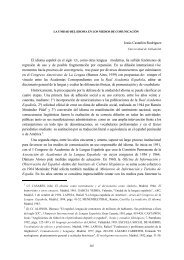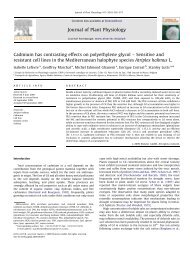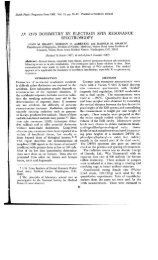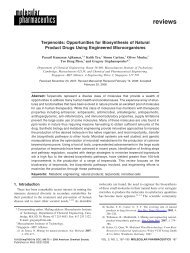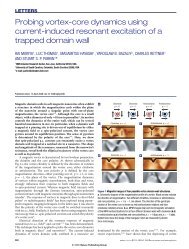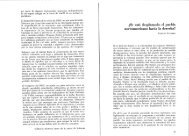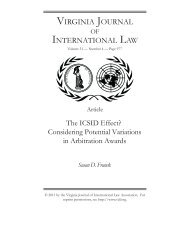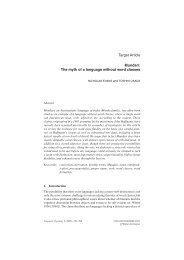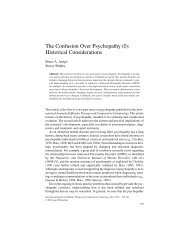Volatile composition of oak and chestnut woods used in brandy ...
Volatile composition of oak and chestnut woods used in brandy ...
Volatile composition of oak and chestnut woods used in brandy ...
Create successful ePaper yourself
Turn your PDF publications into a flip-book with our unique Google optimized e-Paper software.
208 I. Caldeira et al. / Journal <strong>of</strong> Food Eng<strong>in</strong>eer<strong>in</strong>g 76 (2006) 202–211<br />
1.93<br />
1.52<br />
American <strong>oak</strong> wood (CAM) from the others based on<br />
the amounts <strong>of</strong> cis-b-methyl-c-octalactone + 4-methylguaiacol<br />
<strong>and</strong> eugenol.<br />
These results suggest that the analyses <strong>of</strong> certa<strong>in</strong> volatile<br />
compounds found <strong>in</strong> wood could help cooperage<br />
<strong>in</strong>dustry to select or control wood quality, but it must<br />
be done before the toast<strong>in</strong>g process.<br />
3.3. Toast<strong>in</strong>g effect<br />
1.11<br />
Distance<br />
CNEQ0<br />
CFLQ0<br />
CASTQ0<br />
CNEQM<br />
CNGQ0<br />
CFAQL<br />
CASTQL<br />
CNFQM<br />
CFLQL<br />
CNFQ0<br />
CFAQ0<br />
CNGQL<br />
CNGQM<br />
CNFQL<br />
CNEQF<br />
CNFQF<br />
CASTQM<br />
CASTQF<br />
CFAQF<br />
CFAQM<br />
CFLQM<br />
CAMQM<br />
CAMQL<br />
CAMQ0<br />
CNEQL<br />
CNGQF<br />
CFLQF<br />
CAMQF<br />
0.30<br />
Fig. 4. Phenogram <strong>of</strong> UPGMA cluster<strong>in</strong>g <strong>of</strong> all the analysed <strong>woods</strong><br />
accord<strong>in</strong>g to volatile compounds levels. The <strong>in</strong>itial matrix was<br />
composed by 28 <strong>woods</strong> · 15 variables.<br />
Comp. 2<br />
(13%)<br />
0.48<br />
0.13<br />
-0.22<br />
-0.57<br />
Table 3 shows that the toast<strong>in</strong>g degree has a very<br />
highly significant effect on the quantity <strong>of</strong> compounds<br />
0.71<br />
CASTQ0<br />
CASTQM<br />
CNEQF<br />
CNGQM<br />
3<br />
CNEQ0<br />
CASTQF 23<br />
CFAQM<br />
CFAQL<br />
CNGQ0<br />
CNEQM<br />
CNFQF<br />
6<br />
CFLQ0<br />
CNFQM<br />
25<br />
26 2 18<br />
CASTQL<br />
5<br />
CNGQL<br />
CFAQ0 CNFQL<br />
7<br />
24<br />
CFLQL<br />
CNFQ0<br />
CNEQL<br />
8<br />
CAMQL<br />
CFAQF<br />
CFLQM<br />
17<br />
CAMQM<br />
CAMQF<br />
CNGQF<br />
12+13<br />
-0.92<br />
CAMQ0<br />
-0.96 -0.31 0.33<br />
Comp. 1 (50%)<br />
0.98 1.62<br />
9<br />
10<br />
CFLQF<br />
Fig. 5. Projection <strong>of</strong> all <strong>woods</strong> <strong>and</strong> variables <strong>in</strong> the space def<strong>in</strong>ed by<br />
the first <strong>and</strong> second components. (2) acetic acid; (3) furfural; (5)<br />
propanoic acid; (6) 5-methylfurfural; (7) 4-hydroxy-2-butenolactone;<br />
(8) hexanoic acid; (9) guaiacol; (10) trans-b-methyl-c-octalactone,<br />
(12) + (13) cis-b-methyl-c-octalactone + 4-methylguaiacol; (17) eugenol;<br />
(18) syr<strong>in</strong>gol; (23) HMF; (24) 4-allyl-syr<strong>in</strong>gol; (25) vanill<strong>in</strong>; (26)<br />
acetovanillone.<br />
found <strong>in</strong> the wood matrix, <strong>and</strong> for the majority <strong>of</strong> these<br />
compounds, the evolution pr<strong>of</strong>ile is similar: as toast<strong>in</strong>g<br />
<strong>in</strong>tensity <strong>in</strong>creases their concentrations rise (from Q0<br />
until QF), reach<strong>in</strong>g the highest concentrations <strong>in</strong> <strong>woods</strong><br />
strongly toasted (QF).<br />
With toast<strong>in</strong>g <strong>in</strong>tensity <strong>in</strong>crease <strong>and</strong> consequent temperature<br />
raise (Chatonnet et al., 1989; Sarni, Rabier, &<br />
Moutounet, 1990), most <strong>of</strong> the <strong>woods</strong> components suffer<br />
physical, structural <strong>and</strong> chemical changes (Fengel & Wegener,<br />
1989). The thermal degradation <strong>of</strong> wood polysaccharides<br />
orig<strong>in</strong>ates the formation <strong>of</strong> furanic derivatives,<br />
namely furfural, 5-methylfurfural <strong>and</strong> 5-hydroxy-methylfurfural<br />
<strong>and</strong> acetic acid. As summarised by Fengel<br />
<strong>and</strong> Wegener (1989), HMF <strong>and</strong> 5-methylfurfural proceeds<br />
from hexoses, that are the ma<strong>in</strong> constituents <strong>of</strong><br />
cellulose, <strong>and</strong> furfural derives from pentoses, the ma<strong>in</strong><br />
constituents <strong>of</strong> hemicelluloses. The acetic acid proceeds<br />
from the acetyl groups present <strong>in</strong> the wood xylans, an<br />
important group <strong>of</strong> wood hemicelluloses. For this<br />
reason, it was observed a significant <strong>in</strong>crease <strong>in</strong> the<br />
amounts <strong>of</strong> these compounds (acetic acid, furfural,<br />
5-methyl-furfural <strong>and</strong> 5-hydroxymetylfurfural) with the<br />
<strong>in</strong>crease <strong>of</strong> toast<strong>in</strong>g level. It was possible to divide the<br />
<strong>woods</strong> from different toast<strong>in</strong>g levels based on the quantity<br />
<strong>of</strong> these compounds.<br />
The higher contents <strong>of</strong> furanic aldehydes was detected<br />
<strong>in</strong> strongly toasted <strong>woods</strong>, which is <strong>in</strong> agreement<br />
with several authors (Artajona, 1991; Nomdedeu et al.,<br />
1988) but <strong>in</strong> disagreement with Chatonnet et al.<br />
(1989), who found the higher levels <strong>in</strong> medium toasted<br />
<strong>oak</strong>s.<br />
The hemicelluloses are the most thermosensitive<br />
wood polymer (Fengel & Wegener, 1989), they are preferentially<br />
degraded dur<strong>in</strong>g the toast<strong>in</strong>g process, which<br />
expla<strong>in</strong>s the high amount <strong>of</strong> furfural among the furanic<br />
aldehydes (Table 3).<br />
Concern<strong>in</strong>g the amounts <strong>of</strong> 4-hydroxy-2-butenoic<br />
acid lactone, their behaviour with toast<strong>in</strong>g is similar to<br />
the furanic aldehydes.<br />
Under temperature effect wood lign<strong>in</strong>s are also affected<br />
(Fengel & Wegener, 1989), which could expla<strong>in</strong><br />
the presence <strong>of</strong> many phenolic derivatives namely vanill<strong>in</strong>,<br />
volatile phenols <strong>and</strong> acetovanillone.<br />
In fact, it was observed that the toast<strong>in</strong>g level had a<br />
very highly significant effect on the quantity <strong>of</strong> eugenol,<br />
syr<strong>in</strong>gol <strong>and</strong> 4-allyl-syr<strong>in</strong>gol found. Higher values were<br />
found <strong>in</strong> strongly toasted <strong>woods</strong>, <strong>in</strong> disagreement with<br />
other authors (Artajona, 1991; Chatonnet et al., 1989).<br />
The results also show (Fig. 6) that the <strong>in</strong>crease <strong>in</strong> the<br />
amounts <strong>of</strong> syr<strong>in</strong>gyl-type compounds (syr<strong>in</strong>gol <strong>and</strong><br />
4-alylsyr<strong>in</strong>gol) are higher than the ones <strong>of</strong> guaiacyl-type<br />
(guaiacol <strong>and</strong> eugenol) <strong>in</strong> <strong>oak</strong> wood, as described by<br />
Chatonnet et al. (1989) <strong>and</strong> Sarni et al. (1990). This fact<br />
could be expla<strong>in</strong>ed by the dom<strong>in</strong>ance <strong>of</strong> syr<strong>in</strong>gil units <strong>in</strong><br />
the hardwood (<strong>oak</strong> <strong>and</strong> <strong>chestnut</strong>) lign<strong>in</strong>s <strong>and</strong> also by<br />
their higher thermal stability.



